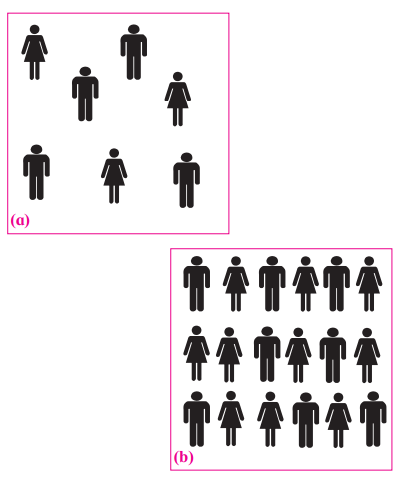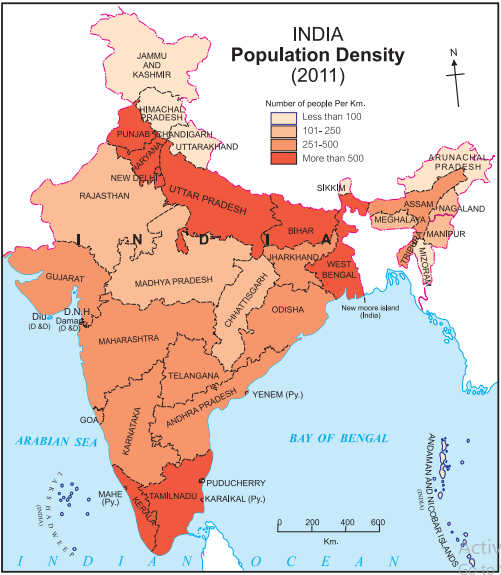EXERCISE
Solutions
1. Are the following sentences right or wrong? Correct the wrong ones.
Question a.
Literacy rate is higher in Brazil than India.
Answer:
Right.
Question b.
In Brazil, people prefer living in the south east as compared to the north east.
Answer:
Right.
Question c.
The life expectancy of Indians is decreasing.
Answer:
Wrong.
Question d.
The north-western part of India is densely populated.
Answer:
Wrong.
Question e.
The western part of Brazil is densely populated.
Answer:
Wrong
2. Answer the following questions as per the instructions:
Question a.
Arrange the following states of India in descending order of their population. Himachal Pradesh, Uttar Pradesh, Arunachal Pradesh, Madhya Pradesh, Andhra Pradesh.
Answer:
Descending order: Uttar Pradesh, Madhya Pradesh, Andhra Pradesh, Himachal Pradesh, Arunachal Pradesh.
Question b.
Arrange the states of Brazil in ascending order of their population: Amazonas, Rio de Janeiro,
Alagoas, Sao Paulo, Parana.
Answer:
States of Brazil: Alagoas, Amazonas, Parana, Rio de Janeiro, Sao Paulo.
Question c.
Classify the factors affecting the distribution of population into favourable and unfavourable.
Answer:
| Favourable Factors | Unfavourable Factors |
| (1) Nearness to Sea | Lack of roads |
| (2) Temperate Climate | Lack of Industries |
| (3) New cities and towns | Tropical moist forests |
| (4) Minerals | Semi arid climate |
| (5) Cultivable land |
3. Answer the following questions:
Question a.
Explain the similarities and differences between the population distribution in Brazil and India.
Answer:
(a) Similarities in population distribution in Brazil and India:
- In Brazil as well as in India, population is very unevenly distributed.
- Inaccessible dense forests and absence of facilities are the barriers to human settlements.
- North, north west and north east of both the countries are the regions of low population.
- Population is concentrated in flat fertile regions which have abundant water resources, transport facilities, mild climate and development of agriculture industries and trade in the plain region.
- Coastal regions are densely populated in Brazil and in India.
(b) Differences between population distribution in Brazil and India.
- The average density of population in India is 382 persons per sq.km, and that of Brazil is about 23 persons per sq.km.
- Though the area of both the countries is occupied by vast river basins, the distribution of population is extremely opposite in both the river basins.
- The Amazon River Basin is sparsely populated while the Ganga River Basin is densely populated.
Question b.
Giving examples, correlated to, climate and population distribution.
Answer:
Climate and population distribution are closely interreleted. Temperature and rainfall, the two elements of climate greatly influence the population concentration.
(i) Dense population is found in regions with mild climate and moderate rainfall.
E.g. the coastal plains of Brazil, the northern plain as well as the coastal plains of India
(ii) Places with heavy rainfall, inaccessibility and dense forests have low population.
E.g. the interiors of the Amazon Basin in Brazil, north eastern states in India.
(iii) The snow covered regions due to extremely cold climatic conditions have less population.
E.g. the northernmost part of Jammu & Kashmir.
(iv) In certain regions, due to less rainfall and extreme climatic conditions population is sparse.
E.g. Thar desert of Rajasthan and the Drought Quadrilateral region of Brazil.
4. Give geographical reasons:
Question a.
Population is an important resource.
Answer:
- The qualitative aspects of a population are important for a nation’s economic and social progress.
- Natural resources of any country gets utilised properly because of the population.
- Economic growth and development will be slow if population resource is not utilised properly.
- Thus an optimum and quality population can bring about a country’s development.
Question b.
Brazil’s population density is very less.
Answer:
- Brazil is the fifth largest country in the world with respect to area and has a population of about 19 crores (Census 2010).
- It occupies 5.6% of world’s total land area and accounts for only 2.78% of the world’s total population.
- Thus Brazil occupies more percent of world’s land and less percent of world’s total population. Therefore,
- the density of population is very less in Brazil, i.e. around 23 persons per sq.km.
Question c.
India’s population density is high.
Answer:
- India is the second most populous country in the world, with a population of about 121 crores (Census 2011).
- India occupies only 2.41% of the land area of the world, but supports 17.5% of the world’s population.
- Thus India has less percent of world’s land and supports high percent of world’s population.
- Hence, India’s average population density is high i.e. 382 persons per sq. km.
Question d.
The density of population is sparse in the Amazon Basin.
Answer:
- The interior part of the Amazon Basin has a very unfavourable hot and humid climate.
- It receives heavy rainfall of nearly 2000 mm and has dense inaccessible forests.
- Transportation, agricultute and industries are not well developed here.
- All these factors are barriers to the development of human settlements.
- So, the density of population is sparse in the Amazon Basin.
Question e.
Population density is high in the Ganga plains.
Answer:
- Ganga plains are fertile low lying plains formed due to the deposition work of River Ganga and its tributaries.
- Mild climate, moderate rainfall and fertile soil have led to the development of agriculture and industries.
- This region also has a dense network of roadways and railways.
- So, the population density is high in the Ganga Plains.
Question 5A.
Compare and classify the population densities shown in the figure ‘a’ and ‘b’ representing 1 sq. km. of area.
Answer:
In the fig. (a) density of population is 7 persons per sq. km. The region is sparsely populated.
In the fig. (b), the density of population is 18 persons per sq. km. The region is densely populated.
Question 5B.
If in figure B one sign = 100, then what will be the sex ratio?
Answer:
One symbol = 100 persons
There are 10 female symbols.
Number of females = 100 x 10
= 1000
There are 8 male symbols
Number of males = 100 x 8
= 800
| Males | 800 | 1000 |
| Females | 1000 | ? |
Number of females = 1000*1000/800
= 1250
Sex Ratio is 1250 females per 1000 males.
Question 6.
Comment upon the population density of fig (b).
(i) fig (b) shows the population density of India as per 2011.
(ii) The density of population is divided into four categories. They are:
(a) Less than 100 persons per sq.km. .
(b) 101-250 persons per sq.km.
(c) 251-500 persons per sq.km.
(d) more than 500 persons per sq.km.
Answer:
| S.No. | Population Density (per sq.km.) | Name of the States / Union Territories |
| (1) | less than 100 | Arunachal Pradesh, Mizoram, Jammu and Kashmir, Himachal Pradesh, Uttarakhand, Sikkim. |
| (2) | 101 to 250 | Meghalaya, Manipur, Nagaland, Rajasthan, Madhya Pradesh, Chattisgarh. |
| (3) | 251 to 500 | Gujarat, Maharashtra, Goa, Karnataka, Andhra Pradesh, Telangana, Odisha, Jharkhand, Assam, Tripura. |
| (4) | more than 501 | West Bengal, Bihar, Punjab, Haryana, Uttar Pradesh,Kerala and Tamil Nadu, Delhi, Chandigarh, Puducherry, Diu, Daman, Dadra Nagar, Haveli, Andaman and Nicobar Islands. |



Leave a Reply